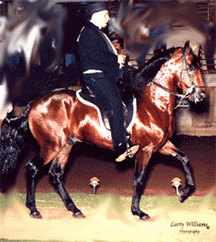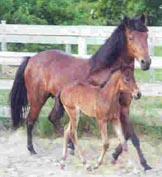|
 |
|
Esta página no está disponible en español. THE MIAMI HERALD Easy Rider: The Versatile Paso Fino's Popularity Is On The Rise In South FloridaBY DANIEL CHANG March 21, 2003
Head and neck elegantly arched, hind quarters and shoulders virtually level, and feet cycling furiously beneath a near-motionless body, the paso fino is the Irish step dancer of the equestrian universe. It is talented. It is tireless. It is, to the hundreds who gathered for the Florida Paso Fino Horse Association show in January, a breathtaking animal. And a complex one, too, because the paso fino's identity has evolved since the breed was introduced in the United States from Latin America after World War II. Whereas Latin Americans, who perfected the breed, prize the horse's pedigree, North Americans value its utility on the ranch and the trail. After experiencing the smooth gait of a paso fino more than a decade ago, Michele Londoño quit her job as a professor at the University of Miami, where she was director of the languages program, and took up breeding and training the horses full time. ''The paso finos are the ultimate ride,'' Londoño says. ``They're the Cadillac of gaited horses. . . . .If you try them, you can't go back.'' A native of France, Londoño had never heard of the paso fino (in Spanish it means 'fine step') until her husband, Carlos, a native of Colombia, introduced her to the breed. Now they own Toddler & Rider Paso Finos, in Homestead and are among the growing ranks of paso fino enthusiasts nationwide. Through converts like the Londoños, the paso fino is shedding its North American obscurity and winning over riders from the cattle ranches of the West to the equestrian trails of Davie, says Valerie Lawrence, who owns Valerie June's Paso Fino Farm in the Redland. ''It's exploding,'' says Lawrence, who first mounted a paso fino in 1988. ``I've sold so many of my paso finos, to [ranchers in] Pennsylvania, North Dakota. They're discovering them. They're great in the mountains and [on] the ranches.'' Fueled in part by Latin American immigrants and South Florida's dominant Hispanic culture, hundreds of paso fino farms have sprouted across the Florida landscape like sea grape and sawgrass. Though the paso fino traces its roots to the Spanish conquistadors, it owes much of its New World popularity to ranchers in Puerto Rico and Colombia, where the breed was perfected. In fact, the breed is so popular among Spanish-speaking riders that Lawrence says she had difficulty learning about paso finos at first.
But that's not likely to last as more people discover that the paso fino is versatile and tireless. Virginia Cullen of Southwest Ranches used to own a quarter horse ''because that's the thing you do in Davie,'' she says. Now, Cullen no longer owns quarter horses, just seven paso finos. Indeed, a subculture of aficionados has taken strong root in South Florida over the past 20 years, as evidenced by the Florida Paso Fino Horse Association show that begins today and runs through Sunday at Tropical Park. More than 350 paso fino horses are registered to compete in categories ranging from the pleasure class, which features jumps and other maneuvers, to the fino class, which requires the horse to canter in precise, four-beat steps. The show -- one of six FPFHA meets scheduled across the state this year -- reflects Florida's history as a paso fino pioneer in the United States. As early as 1968, paso fino exhibitions and competitions have been held in South Florida. Since then, interest has risen steadily. Membership in the FPFHA has grown from roughly 400 in 1973 to more than 1,200 today. Nationally, the Paso Fino Horse Association has about 7,000 members and more than 30,000 horses registered. Most paso fino aficionados say they are drawn to the horse's smooth gait. With five herniated discs in her spine, Lawrence says the paso fino gait is the only one she can tolerate. Lately, the horse has demonstrated remarkable versatility, too, Lawrence says, that proves it can be a great Western horse, which is what most North American riders desire. ``Most Americans don't understand that . . . you can canter him like a Western horse does. You can neck rein him, like a Western horse. You can teach him to jump, bow, do flying lead changes, do rodeo spins, run barrels.'' Luis Gilberto Duarte, president of the FPFHA, says he has been impressed with the new directions that American paso fino trainers have taken the breed. ''They're using them to herd cattle, for trail rides,'' he says. Duarte, who has been an avid paso fino fan since childhood in his native Venezuela, says he relishes watching the horses perform as much as he does riding them. ''Americans enjoy the ride,'' he says. ''We enjoy the ride and the spectacle. It's like watching [José] Canseco hit a home run.'' Nothing, he says, matches the enthusiasm of breeding the horses. The emphasis on pedigree will be evident at this weekend's show, where judges will focus on the unique paso fino gait, which the horses exhibit at birth. For some horse aficionados, though, the emphasis on show is misplaced. Sometimes, only three of as many as 85 show categories highlight the horse's ability to jump and maneuver around obstacles. ''If you miss those classes, all you think the horse can do is walk fancy and that's what happens,'' Lawrence says. 'People think, `That's great. But I want to go on a trail ride.' '' In time, says Sharon Quinn Dixon, past president of the FPFHA, all horse enthusiasts will know what the paso fino can do. ''It's still growing, still unknown because it doesn't have the history in this country,'' Dixon says. ``We're still making the history.''
|

 The horse does not so much walk as it appears to dance across the wooden walkway in the hippodrome of Miami's Tropical Park.
The horse does not so much walk as it appears to dance across the wooden walkway in the hippodrome of Miami's Tropical Park. ''I wanted knowledge about it and everybody spoke Spanish,'' says Lawrence, who bought her first paso fino at an auction in Georgia about 15 years ago. She attributes Americans' general lack of knowledge about paso finos to the language barrier. Another obstacle to the horse's popularity, she says, is that paso fino shows do not emphasize its ability to jump, lead and perform tasks.
''I wanted knowledge about it and everybody spoke Spanish,'' says Lawrence, who bought her first paso fino at an auction in Georgia about 15 years ago. She attributes Americans' general lack of knowledge about paso finos to the language barrier. Another obstacle to the horse's popularity, she says, is that paso fino shows do not emphasize its ability to jump, lead and perform tasks.